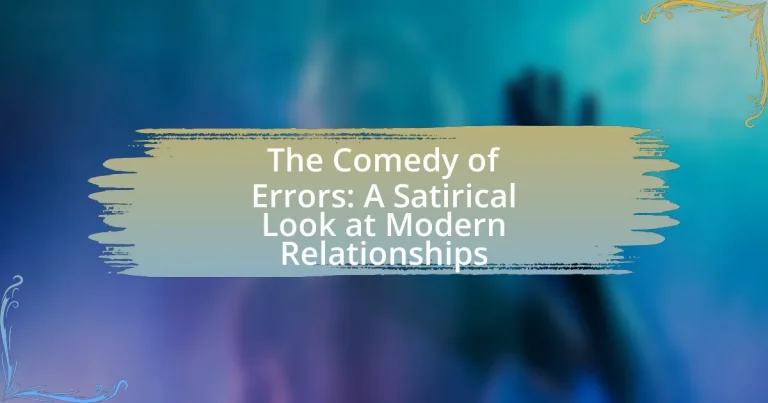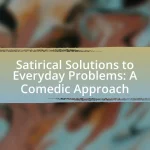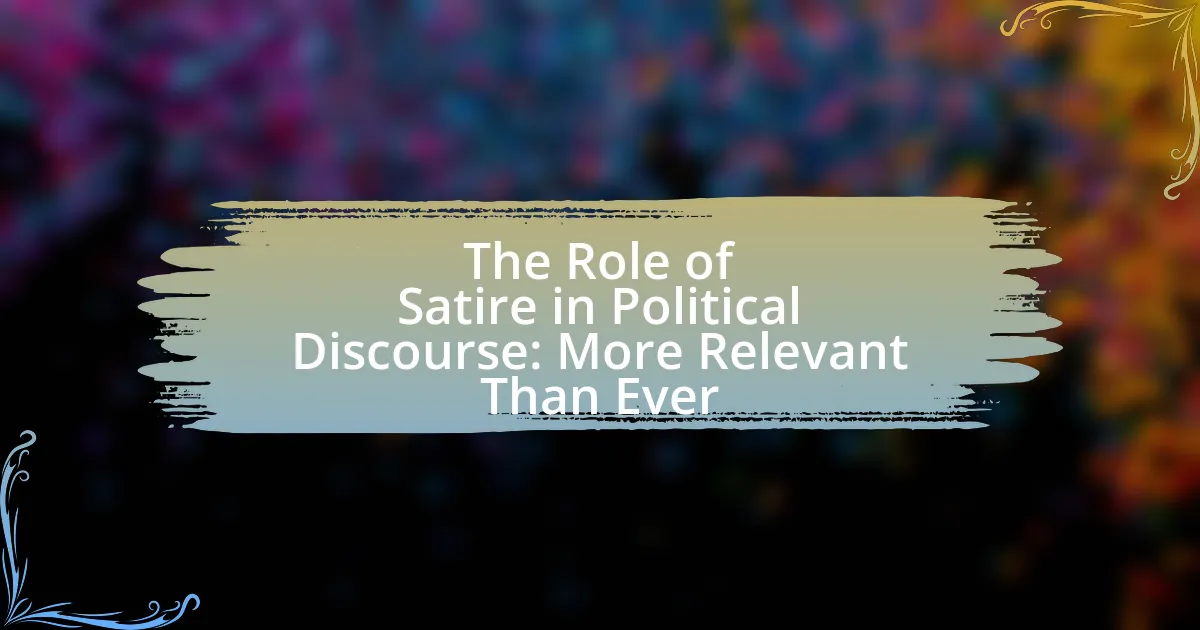‘The Comedy of Errors’ is a play by William Shakespeare that examines themes of mistaken identity, confusion, and the intricacies of relationships, making it relevant to modern dynamics. The article explores how the play reflects contemporary relationship challenges, such as miscommunication and societal expectations, while emphasizing the importance of clear communication and trust. It also discusses the role of humor and satire in addressing serious relationship topics, the evolution of character dynamics, and the lessons that can be drawn from the play to improve real-life relationships. Through its comedic portrayal of relational turmoil, the play serves as a timeless commentary on the nature of human connections.
What is ‘The Comedy of Errors’ and its relevance to modern relationships?
‘The Comedy of Errors’ is a play by William Shakespeare that explores themes of mistaken identity, confusion, and the complexities of relationships. Its relevance to modern relationships lies in its depiction of how misunderstandings and miscommunications can lead to chaos and conflict, mirroring the challenges faced in contemporary romantic and familial interactions. The play illustrates that even in the midst of confusion, love and reconciliation can prevail, highlighting the importance of communication and trust in maintaining relationships.
How does ‘The Comedy of Errors’ reflect contemporary relationship dynamics?
‘The Comedy of Errors’ reflects contemporary relationship dynamics through its exploration of mistaken identities and the chaos that ensues from miscommunication. The play illustrates how misunderstandings can lead to conflict and confusion in relationships, mirroring the complexities of modern interactions where digital communication often results in misinterpretations. For example, the duality of the twin characters highlights the theme of identity and the challenges of recognizing and understanding one another, which is relevant in today’s diverse social landscape where individuals often grapple with their roles and perceptions in relationships. This comedic portrayal of relational turmoil underscores the importance of clear communication and the potential for humor in resolving conflicts, making it a timeless commentary on the nature of human connections.
What themes in ‘The Comedy of Errors’ resonate with today’s societal norms?
Themes in ‘The Comedy of Errors’ that resonate with today’s societal norms include identity confusion, the complexity of relationships, and the impact of societal expectations. Identity confusion is evident through the mistaken identities of the twin brothers, which reflects contemporary issues of self-discovery and the search for authenticity in a world filled with social media personas. The complexity of relationships is highlighted through the misunderstandings and conflicts between characters, mirroring today’s challenges in communication and trust within personal relationships. Additionally, societal expectations are portrayed through the pressures faced by characters to conform to roles, paralleling modern societal norms regarding marriage, fidelity, and social status. These themes illustrate the timeless nature of human experiences and the ongoing relevance of Shakespeare’s work in understanding contemporary social dynamics.
How do misunderstandings in the play mirror modern communication issues?
Misunderstandings in “The Comedy of Errors” reflect modern communication issues by illustrating how misinterpretations and lack of clarity can lead to conflict and confusion. The play showcases characters who misidentify one another due to mistaken identities, paralleling how digital communication often results in miscommunication through text, emojis, or social media. For instance, the rapid exchange of messages can lead to assumptions that are not based on full context, similar to how characters jump to conclusions without verifying information. This highlights the ongoing challenge of effective communication in contemporary society, where nuances can be lost, leading to misunderstandings that escalate into larger problems.
Why is satire an effective tool in exploring relationships in ‘The Comedy of Errors’?
Satire is an effective tool in exploring relationships in ‘The Comedy of Errors’ because it highlights the absurdities and misunderstandings inherent in human interactions. The play employs comedic elements to exaggerate the confusion between the two sets of twins, which serves to critique societal norms and expectations surrounding love and identity. For instance, the mistaken identities lead to humorous yet poignant situations that reveal the fragility and complexity of relationships, illustrating how easily trust can be undermined by miscommunication. This satirical approach allows audiences to reflect on their own relationships, recognizing the often ridiculous nature of their conflicts and the importance of clarity and understanding.
What role does humor play in addressing serious relationship topics?
Humor serves as a vital tool in addressing serious relationship topics by facilitating open communication and reducing tension. When couples use humor, they can approach sensitive issues with a lighter perspective, making it easier to discuss feelings and concerns without escalating conflict. Research indicates that humor can enhance emotional resilience and foster connection, as seen in a study by Robert Provine, which highlights that laughter can strengthen social bonds and improve interpersonal relationships. By incorporating humor, partners can create a safe space for dialogue, allowing them to navigate difficult conversations more effectively.
How does satire enhance the audience’s understanding of character flaws?
Satire enhances the audience’s understanding of character flaws by exaggerating and ridiculing these flaws, making them more visible and relatable. Through humor and irony, satire highlights the absurdities of human behavior, allowing the audience to recognize and reflect on these imperfections in themselves and others. For example, in “The Comedy of Errors,” the use of mistaken identities and misunderstandings serves to amplify the characters’ shortcomings, such as jealousy and pride, thereby facilitating a deeper comprehension of these traits. This method encourages critical thinking about personal and societal issues, as audiences can see the consequences of such flaws in a comedic context.
What are the key characters in ‘The Comedy of Errors’ and their relationship dynamics?
The key characters in ‘The Comedy of Errors’ include the twin brothers Antipholus of Syracuse and Antipholus of Ephesus, their respective servants Dromio of Syracuse and Dromio of Ephesus, and the characters Adriana, Luciana, and the Courtesan. The relationship dynamics are primarily driven by mistaken identities and confusion, as the two sets of twins, separated at birth, encounter each other without realizing their true identities.
Antipholus of Syracuse is in search of his brother and ends up being mistaken for Antipholus of Ephesus, leading to a series of comedic misunderstandings. Dromio of Syracuse, serving Antipholus of Syracuse, experiences similar confusion when he is mistaken for Dromio of Ephesus, who serves Antipholus of Ephesus. Adriana, the wife of Antipholus of Ephesus, becomes increasingly frustrated with her husband’s perceived neglect, while Luciana, her sister, offers a contrasting perspective on love and marriage. The Courtesan adds to the chaos by claiming a relationship with Antipholus of Ephesus, further complicating the dynamics.
These interactions highlight themes of love, loyalty, and the absurdity of relationships, showcasing how misunderstandings can lead to both comedic and poignant moments.
How do the twin characters contribute to the play’s exploration of identity and relationships?
The twin characters in “The Comedy of Errors” significantly contribute to the play’s exploration of identity and relationships by creating confusion and highlighting the complexities of human connections. Their mistaken identities lead to a series of comedic misunderstandings that reveal how easily relationships can be misinterpreted and how personal identity can be obscured by external perceptions. For instance, the interactions between the twins not only drive the plot but also serve to illustrate the theme of duality in human nature, as characters grapple with their own identities in relation to others. This dynamic emphasizes the fragility of relationships, showcasing how identity is often shaped by social interactions and the perceptions of those around us.
What conflicts arise from the mistaken identities of the twins?
The conflicts arising from the mistaken identities of the twins in “The Comedy of Errors” include confusion, mistaken accusations, and disrupted relationships. The twins, Antipholus of Syracuse and Antipholus of Ephesus, create chaos as they are frequently mistaken for one another, leading to wrongful arrests and misunderstandings with their respective partners. For instance, Antipholus of Ephesus is accused of being unfaithful due to the actions of his twin, which strains his marriage. Additionally, the confusion extends to their servants, Dromio of Syracuse and Dromio of Ephesus, who also face similar identity mix-ups, resulting in comedic yet serious consequences. This mistaken identity theme highlights the complexities and absurdities of modern relationships, reflecting how miscommunication can lead to significant conflict.
How do the twins’ relationships with other characters evolve throughout the play?
The twins’ relationships with other characters evolve significantly throughout “The Comedy of Errors.” Initially, the twins, Antipholus of Syracuse and Antipholus of Ephesus, are unaware of each other’s existence, leading to confusion and mistaken identities. As the play progresses, their interactions with characters such as Dromio, their servants, and their respective love interests reveal deeper connections and misunderstandings. For instance, the mistaken identities create comedic situations that ultimately lead to revelations about loyalty and familial bonds. By the end of the play, the twins’ reunion not only resolves the chaos but also strengthens their relationships with others, highlighting themes of identity and reconciliation.
What role do secondary characters play in shaping the main relationships?
Secondary characters significantly influence the main relationships by providing context, conflict, and support that shape the dynamics between primary characters. In “The Comedy of Errors,” for instance, the interactions of secondary characters, such as the Dromios and the various townspeople, create misunderstandings and comedic situations that highlight the complexities of the main relationships. These characters often serve as catalysts for the actions and decisions of the protagonists, revealing their traits and motivations through contrast and comparison. The presence of secondary characters enriches the narrative, illustrating how external influences can impact personal connections and contribute to the overall theme of mistaken identity and relational chaos.
How do the servants’ actions influence the plot and character interactions?
The servants’ actions significantly influence the plot and character interactions in “The Comedy of Errors” by driving misunderstandings and mistaken identities. For instance, the servant Dromio of Syracuse’s interactions with various characters lead to comedic confusion, as he is often mistaken for his twin brother Dromio of Ephesus. This mistaken identity propels the narrative forward, creating a series of humorous situations that affect the main characters’ relationships. The chaos generated by the servants’ actions highlights themes of confusion and the complexities of human relationships, ultimately revealing deeper insights into the nature of identity and connection.
What insights do secondary characters provide about societal expectations in relationships?
Secondary characters in “The Comedy of Errors” reveal societal expectations in relationships by embodying various roles that reflect cultural norms and pressures. For instance, characters like Dromio serve as comedic foils, highlighting the absurdity of romantic pursuits and the expectations placed on individuals to conform to societal ideals of love and loyalty. Their interactions often expose the contradictions in these expectations, such as the tension between personal desire and societal approval. This dynamic illustrates how secondary characters can critique and satirize the rigid frameworks that govern relationships, ultimately prompting audiences to question the validity of these norms.
How does ‘The Comedy of Errors’ compare to other works addressing modern relationships?
‘The Comedy of Errors’ employs mistaken identities and misunderstandings to explore themes of love and relationships, paralleling modern works that similarly address the complexities of romantic entanglements. In contemporary literature and media, such as the television series ‘Friends’ or the novel ‘The Rosie Project,’ characters navigate misunderstandings and the challenges of love, reflecting the same comedic elements found in Shakespeare’s play. Both ‘The Comedy of Errors’ and these modern works highlight the absurdities and confusions inherent in relationships, demonstrating that the core issues of love, trust, and identity remain relevant across time.
What similarities exist between ‘The Comedy of Errors’ and contemporary romantic comedies?
‘The Comedy of Errors’ and contemporary romantic comedies share several key similarities, primarily revolving around mistaken identities and comedic misunderstandings. Both genres utilize these elements to create humor and drive the plot, often leading to chaotic situations that ultimately resolve in romantic unions. For instance, in ‘The Comedy of Errors,’ the confusion between the two sets of twins leads to a series of humorous encounters and mistaken assumptions about love and relationships. Similarly, modern romantic comedies frequently employ misunderstandings and mistaken identities, such as in films like ‘The Proposal’ or ’10 Things I Hate About You,’ where characters navigate through comedic scenarios that stem from miscommunication. This reliance on humor derived from confusion is a hallmark of both ‘The Comedy of Errors’ and contemporary romantic comedies, illustrating how timeless comedic tropes continue to resonate in modern storytelling.
How do both genres utilize misunderstandings to drive the narrative?
Both comedy and drama genres utilize misunderstandings as a central mechanism to propel the narrative forward. In comedy, misunderstandings often lead to humorous situations, creating a series of comedic events that engage the audience and highlight the absurdities of relationships. For instance, in Shakespeare’s “The Comedy of Errors,” mistaken identities result in a cascade of comedic mishaps that ultimately reveal deeper truths about love and connection. In drama, misunderstandings can create tension and conflict, driving character development and emotional depth. A prime example is in modern dramas where miscommunication between characters leads to tragic outcomes, emphasizing the fragility of human relationships. Thus, both genres effectively use misunderstandings to explore themes of connection, identity, and the complexities of interpersonal dynamics.
What lessons can be drawn from comparing these works?
Comparing “The Comedy of Errors” with contemporary works reveals lessons about the complexities of modern relationships, particularly the themes of mistaken identity and miscommunication. These themes illustrate how misunderstandings can lead to conflict and chaos in both Shakespeare’s time and today, emphasizing the timeless nature of relational challenges. For instance, the play’s use of mistaken identities mirrors the confusion often found in modern dating scenarios, where assumptions and misinterpretations can derail connections. This comparison highlights the importance of clear communication and self-awareness in fostering healthy relationships, a lesson that remains relevant across eras.
How can ‘The Comedy of Errors’ inform our understanding of modern relationship challenges?
‘The Comedy of Errors’ illustrates the complexities of modern relationship challenges through its themes of mistaken identity and miscommunication. The play’s plot revolves around two sets of identical twins, leading to a series of misunderstandings that highlight how easily relationships can become strained due to lack of clarity and assumptions. This mirrors contemporary issues where partners often misinterpret intentions or fail to communicate effectively, resulting in conflict. The chaotic interactions in the play serve as a reminder that clarity and open dialogue are essential for resolving misunderstandings, a principle that remains relevant in today’s relational dynamics.
What practical insights can be gained from the play’s exploration of communication issues?
The play “The Comedy of Errors” provides practical insights into the complexities of communication, highlighting how misunderstandings can lead to chaos and conflict in relationships. The frequent mix-ups between characters, stemming from mistaken identities and miscommunication, illustrate the importance of clarity and context in interactions. For instance, the confusion between the two sets of twins leads to a series of comedic yet revealing situations that underscore how assumptions can distort reality. This serves as a reminder that effective communication requires active listening and verification to avoid unnecessary complications in personal and social dynamics.
How can the lessons from the play be applied to improve real-life relationships?
The lessons from “The Comedy of Errors” can be applied to improve real-life relationships by emphasizing the importance of communication and understanding. The play illustrates how misunderstandings and lack of clear communication can lead to conflict and chaos, which mirrors real-life scenarios where assumptions can damage relationships. For instance, the characters’ mistaken identities and miscommunications highlight the necessity of open dialogue to clarify intentions and feelings. By fostering an environment where individuals feel comfortable expressing themselves and actively listening to one another, relationships can become more resilient and harmonious.
What are some best practices for navigating misunderstandings in relationships inspired by ‘The Comedy of Errors’?
To navigate misunderstandings in relationships, inspired by ‘The Comedy of Errors’, individuals should prioritize clear communication, actively listen, and seek clarification. Clear communication prevents assumptions that lead to confusion, as seen in the play where mistaken identities create chaos. Actively listening to partners fosters understanding and reduces the likelihood of misinterpretations. Seeking clarification when uncertain helps to resolve potential conflicts before they escalate, mirroring the resolution of misunderstandings in the narrative. These practices are essential for maintaining healthy relationships and avoiding the pitfalls depicted in the play.





